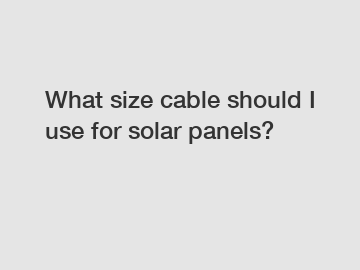What size cable should I use for solar panels?
What size cable should I use for solar panels?
The question of what size cable to use for solar panels is a crucial one, as it directly impacts the performance and safety of your solar power system. With the increasing popularity of solar energy, it is essential to understand the significance of selecting the appropriate cable size for your solar panel installation. In this article, we will explore various points to consider when determining the cable size, ensuring optimal efficiency and adherence to safety standards.
1. Cable Size and Power Loss: .

When electricity is transmitted through a cable, some power inevitably gets lost as heat due to resistance. To minimize power loss and increase efficiency, it is necessary to choose a cable size that reduces resistance. The longer the cable distance and the higher the current, the larger the cable size required. Using smaller cables than recommended can lead to significant power losses, hampering overall system performance.
2. Calculating Voltage Drop:
Another critical factor in determining the cable size is voltage drop. Voltage drop occurs when there is reduced voltage at the end of a cable compared to the source voltage. Excessive voltage drop can result in decreased power output, especially in long cable runs. It is advisable to limit voltage drop to no more than 2% of the system voltage. By calculating the voltage drop based on cable length and current, you can select an appropriate cable size that keeps the losses within the acceptable range.
3. Ampacity and Current Carrying Capacity:
The ampacity of a cable refers to its ability to carry current without overheating. Choosing a cable with insufficient ampacity can lead to insulation degradation and even fire hazards. The National Electrical Code (NEC) provides guidelines for ampacity ratings of different cable sizes based on their temperature ratings. It is important to refer to these standards while selecting the cable to ensure it can handle the maximum current expected in your solar panel system.
4. Temperature Considerations:
Solar panel systems are exposed to varying temperatures, which can impact cable performance. When selecting a cable, it is crucial to consider its temperature rating. Higher temperature ratings allow cables to withstand heat without degrading. Cables with lower temperature ratings may pose a safety risk or experience accelerated aging when exposed to high temperatures, potentially leading to system failures.
To summarize, selecting the right cable size for your solar panel installation is crucial for maximizing system efficiency and ensuring the safety of your setup. Factors such as power loss, voltage drop, ampacity, and temperature considerations directly impact cable selection. By considering these points, you can make an informed decision regarding cable size, allowing your solar panels to deliver optimal performance for years to come.
In conclusion, choosing the appropriate cable size is essential for an efficient and safe solar panel system. Neglecting cable size considerations can lead to significant power losses, reduced voltage output, and potential safety hazards. By carefully evaluating power loss, voltage drop, ampacity, and temperature ratings, you can select the correct cable size to achieve maximum performance and longevity of your solar panel installation. So, next time you ask yourself, "What size cable should I use for solar panels?", make sure to consider all these points for a successful and hassle-free solar power system.
Are you interested in learning more about solar cable 16mm, 16 mm2 steel tape armored cable, Rubber Flexible Power Cable? Contact us today to secure an expert consultation!


